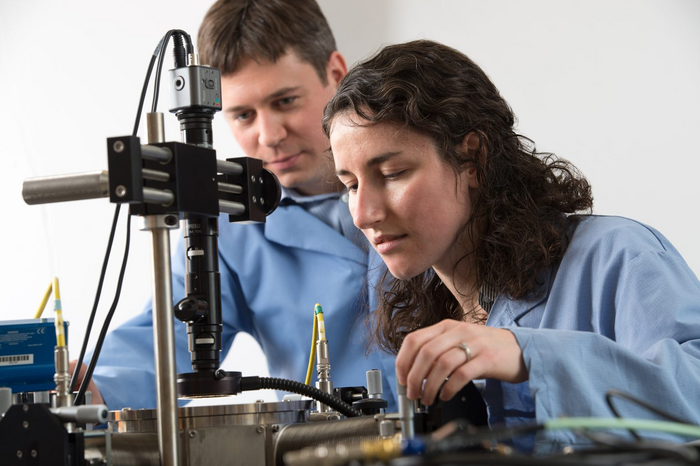Researchers from the Department of Chemistry at the University of North Carolina at Chapel Hill have developed silicon nanowires that can convert sunlight into electricity by splitting water into oxygen and hydrogen gas, providing a greener alternative to fossil fuels.

From left to right: James Cahoon and Taylor Teitsworth. Image Credit: Steve Exum
Researchers initially illustrated that liquid water could be split into oxygen and hydrogen gas using electricity generated by illuminating a semiconductor electrode five decades ago. Although solar-powered hydrogen is an encouraging form of clean energy, low efficiencies, and high costs have hampered the commercialization of solar-powered hydrogen plants.
According to economic feasibility analysis, using a slurry of nanoparticle-based electrodes rather than a rigid solar panel design could significantly reduce costs, attempting to make solar-produced hydrogen competitive with fossil fuels.
However, the majority of currently available particle-based light-activated catalysts, also known as photocatalysts, can only absorb ultraviolet radiation, restricting their energy-conversion efficiency under solar illumination.
James Cahoon, Ph.D., Hyde Family Foundation Professor of Chemistry in the College of Arts and Sciences at UNC-Chapel Hill, and his colleagues have been working on the chemical synthesis of semiconductor nanomaterials with unique physical properties that can facilitate a variety of technologies ranging from solar cells to solid-state memory. Cahoon is the corresponding author of the study, which was published in Nature on February 9th, 2023.
Cahoon and his associates created new silicon nanowires with multiple solar cells along their axis to generate the power required to split water.
This design is unprecedented in previous reactor designs and allows silicon to be used for the first time in a PSR.
Taylor Teitsworth, Postdoctoral Research Associate, University of North Carolina at Chapel Hill
Taylor Teitsworth is a Research Associate in Cahoon’s laboratory.
Silicon is capable of absorbing both visible and infrared light. Because of this and other properties, such as its abundance, low toxicity, and stability, it has historically been an ultimate candidate for solar cells, also known as photovoltaic cells and semiconductors.
Due to the electronic properties of silicon particles, the only way to drive water splitting wirelessly is to encode multiple photovoltaic cells in each particle. This can be accomplished by creating particles with multiple interfaces, known as junctions, between two types of silicon—p-type and n-type semiconductors.
Cahoon’s past study concentrated on the bottom-up synthesis and spatially controlled modulation of silicone with boron for p-type nanowires and phosphorus for n-type nanowires to confer preferable geometries and functionalities.
We used this approach to create a new class of water-splitting multijunction nanoparticles. These combine the material and economic advantages of silicon with the photonic advantages of nanowires that have a diameter smaller than the wavelength of absorbed light. Owing to the inherent asymmetry of the wire junctions, we were able to use a light-driven electrochemical method to deposit the co-catalysts selectively onto the ends of the wires to enable water splitting.
James Cahoon, Professor of Chemistry, College of Arts and Sciences, University of North Carolina at Chapel Hill
The study was funded by grant CBET-1914711 from the National Science Foundation (NSF) with foundational work supported by the Alliance for Molecular Photoelectrode Design for Solar Fuels, an Energy Frontier Research Center funded by the US Department of Energy, Office of Science, Office of Basic Energy Sciences under award no. DE-SC0001011.
The Chapel Hill Analytical and Nanofabrication Laboratory, a member of the North Carolina Research Triangle Nanotechnology Network backed by NSF grant ECCS-2025064 as part of the National Nanotechnology Coordinated Infrastructure, helped with device fabrication and electron microscopy imaging and analysis. The University of North Carolina at Chapel Hill’s Research Computing group also offered computational resources for optical simulations.
The study received additional support from the NSF by grant CHE-1848278 for s-SNOM characterization and through different individual graduate research fellowships.